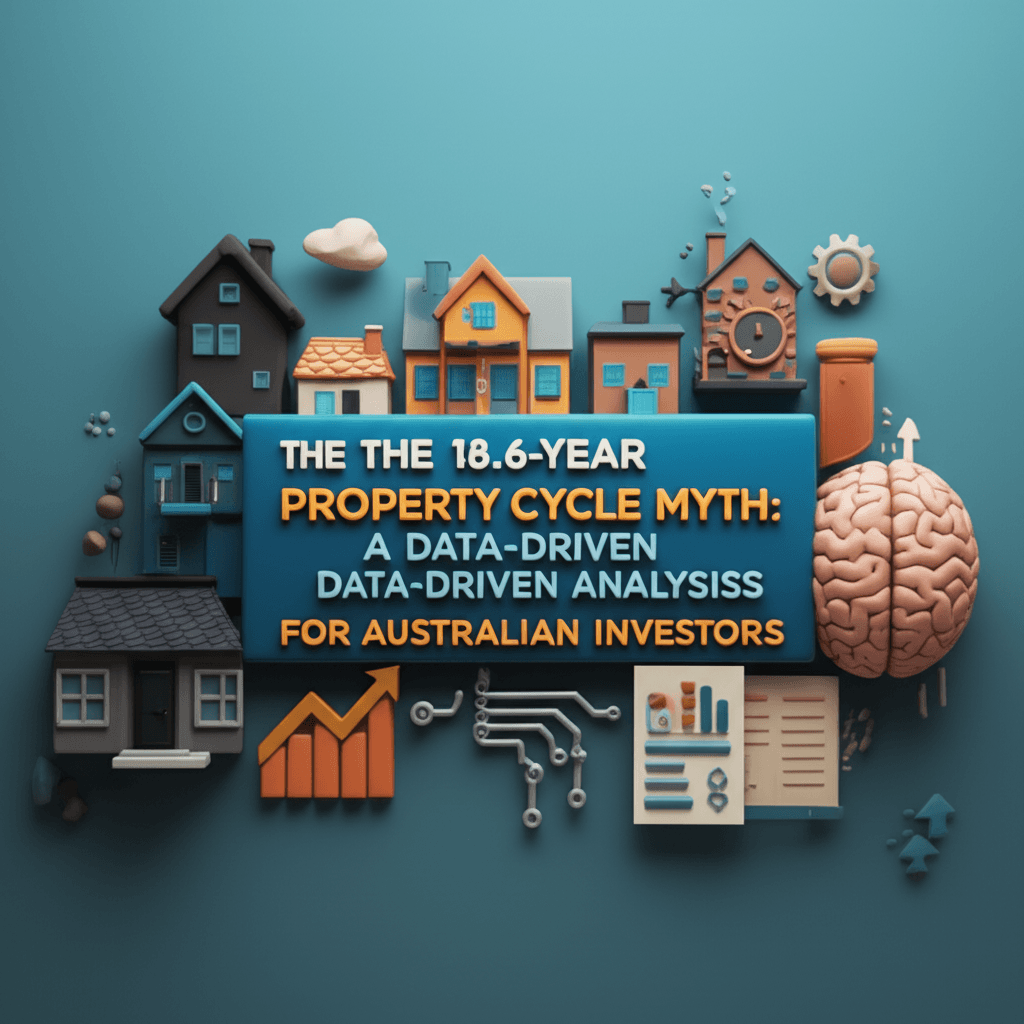The 18.6-Year Property Cycle Myth: A Data-Driven Analysis for Australian Investors
Discover why historical data from Australia, the US, and the UK proves this popular investment theory is unreliable for predicting market booms.

Is There a Secret Clock Timing the Property Market?
Navigating the Australian property market in mid-2025 can feel overwhelming. Amidst fluctuating interest rates and endless commentary, investors often search for a reliable guide—a 'secret formula' to predict the next boom. One of the most persistent theories is the 18.6-year property cycle, a concept promising a predictable rhythm to real estate booms and busts.
But what if this widely cited rule is more fiction than fact? Relying on a flawed model can lead to disastrous investment decisions. This article puts the 18.6-year cycle to the test, using decades of historical data from Australia and around the world. We'll move beyond opinion and hearsay to provide a clear, data-driven verdict on whether this cycle is a trustworthy tool or a dangerous myth.
Understanding the 18.6-Year Property Cycle Theory
The theory suggests that real estate markets move in a consistent and predictable cycle lasting approximately 18.6 years. Proponents claim this cycle has distinct phases, culminating in a major peak, followed by a recession, and then a recovery period leading into the next upswing. The idea is alluring because it offers a simple timeline for investors: buy at the bottom, hold through the growth phase, and sell near the top.
The specific 18.6-year figure is often anecdotally linked to everything from historical US land value data to, bizarrely, the lunar nodal cycle. However, for any theory to be useful for modern investors, it must hold up against verifiable, contemporary data. Let's see if it does.
Putting the Theory to the Test: Australian National Data
To begin, we analysed residential property data for Australia spanning from 1981 to 2024—a total of 44 years. Instead of looking at ever-rising median prices, we examined the annual percentage growth rate. This method clearly shows the peaks (booms) and troughs (downturns) in the market.
According to the 18.6-year theory, we should see distinct, powerful booms spaced roughly two decades apart. However, the data reveals a far more erratic picture.
When we define a 'boom' as a period of significant growth (e.g., over 15% per annum), we can identify several peaks over the last four decades. The critical finding, however, is the time between these peaks. The gaps are wildly inconsistent:
The first major gap between booms is approximately 14 years.
Subsequent gaps are significantly shorter, some less than a decade.
If the cycle was a reliable 18.6 years, the timing of these events would be consistent. Instead, the historical data shows that market peaks are irregular. Relying on a fixed 18.6-year clock would have caused an investor to completely miss major growth periods or buy in at the wrong time. This initial look at the national data suggests the theory is, at best, unreliable. True market analysis requires more sophisticated [real estate analytics](https://houseseeker.com.au/features/real-estate-analytics) that account for dozens of dynamic variables, not a single, fixed timeline.
[INSERT_IMAGE: "A line graph showing the volatile annual percentage growth of Australian residential property from 1981 to 2025, highlighting inconsistent peaks and troughs."]
A Closer Look: Do Capital Cities Follow the Cycle?
Some advocates of the theory suggest that national data averages out the 'true' cycle, which is supposedly more visible at the city level. To investigate this claim, we analysed the historical growth data for Australia’s three largest capital cities: Sydney, Melbourne, and Brisbane.
Sydney's Property Market
Sydney's market is known for its volatility and significant booms. Yet, when we chart its annual growth over the last 44 years, no 18.6-year pattern emerges. Depending on whether you define a boom as 20% or 30% annual growth, you get a different number of peaks, but in every scenario, the gaps between them are inconsistent:
Using a 20% growth benchmark, the average gap between booms is less than 10 years.
At times, the gap is as long as 23 years, while at others, it's as short as 8 years.
The data shows that Sydney’s market moves according to its own complex set of economic drivers—such as local economic performance, population shifts, and housing supply—not a predetermined cycle.
Melbourne's Property Market
Melbourne's data tells a similar story. If we set the benchmark for a 'boom' at 25% annual growth, Melbourne has only experienced two such events in the last 45 years, both over 30 years ago. This alone makes a repeating 18.6-year cycle impossible.
Even if we lower the bar to 20% growth, we find four boom periods. However, the average gap between these events is only eight years, less than half the supposed cycle length. Furthermore, the timing is erratic, proving that Melbourne's property market performance cannot be predicted with a simple, fixed timeline.
Brisbane's Property Market
Brisbane’s property market history also fails to align with the 18.6-year theory. Over the past 44 years, there have been four clear growth peaks. With three gaps between these four peaks, the average duration between them is approximately 13 years. This is far from 18.6 years, and once again, the individual gaps are inconsistent in length. The data is clear: the 18.6-year cycle is not a reliable indicator for Brisbane, Sydney, or Melbourne.
Global Perspective: Examining US and UK Markets
If the cycle doesn't apply to Australia, perhaps it's an international phenomenon? The theory originated from analysis of US data, so we examined historical records from the [Federal Reserve Bank of St. Louis](https://fred.stlouisfed.org/), covering over 60 years of US property prices.
In a 60-year period, we should see three clear 18.6-year cycles. Instead, the US data shows five or even six distinct peaks. This results in an average gap of around 11 years between booms—again, nowhere near 18.6. The foundational evidence for the theory doesn't even hold up in its country of origin.
We see the same pattern in the United Kingdom. Data from the UK Land Registry spanning 50 years shows four clear peaks. The average gap between them is only 10 years, and the timing is, once again, inconsistent.

The Verdict: Data Trumps Dogma in Property Investing
The evidence is conclusive. After examining decades of data from Australia, Sydney, Melbourne, Brisbane, the USA, and the UK, there is no statistical basis for a predictable 18.6-year property cycle. While markets are cyclical in nature, these cycles are irregular, inconsistent, and driven by a complex interplay of economic factors, including:
Interest rates and credit availability
Population growth and demographic shifts
Government policy and infrastructure investment
Local and global economic health
Housing supply and construction levels
Believing in a fixed cycle is not just wrong; it's dangerous. It encourages investors to ignore current, crucial data points in favour of a simplistic, one-size-fits-all timeline. True investment success comes from diligent research and focusing on market fundamentals.
Instead of asking 'Where are we in the 18.6-year cycle?', successful investors ask better questions:
Which suburbs are showing consistent demand and low vacancy rates?
Where is the government investing in new infrastructure that will drive future growth?
How can I find properties that match my specific lifestyle and financial goals?
Answering these questions requires real-time data, not a dusty theory. Modern tools like an [AI property search](https://houseseeker.com.au/features/ai-property-search) can help you filter through the noise and find opportunities based on current, relevant metrics—not a mythical clock.
Conclusion
The 18.6-year property cycle is an appealingly simple concept, but it falls apart under scrutiny. Our deep dive into decades of real-world data shows it is not a reliable tool for forecasting property booms in Australia or anywhere else. The gaps between market peaks are inconsistent and do not follow a predictable pattern.
For investors aiming for long-term success, the key is to move past such myths. Success lies in leveraging powerful [real estate analytics](https://houseseeker.com.au/features/real-estate-analytics) to understand the specific drivers of growth in today's market. By focusing on solid data and fundamentals, you can build a robust strategy that doesn't depend on unproven theories.
Ready to move beyond myths and make data-backed investment decisions? Explore HouseSeeker's powerful [real estate analytics tools](https://houseseeker.com.au/features/real-estate-analytics) to uncover genuine opportunities in today's market.
Frequently Asked Questions
If the 18.6-year cycle is a myth, how should I time the market?
Instead of 'timing the market' based on a fixed cycle, focus on 'time in the market' and buying based on strong fundamentals. A good time to buy is when you have your finances in order and can identify a high-quality property in an area with solid growth drivers, such as strong population growth, infrastructure development, and low supply. Market conditions are important, but individual property selection is paramount.
Where does the 18.6-year number even come from?
While the exact origin is debated, many trace it back to early 20th-century economic theorists who observed patterns in US land sales. Some have even tried to link it to the 18.6-year lunar nodal cycle, a cycle related to the Moon's orbit. However, there is no credible economic evidence to suggest the Moon's orbit influences real estate prices. As our analysis shows, the pattern does not hold up against modern, verifiable data.
What data points are more reliable than property cycles?
Reliable indicators are those that directly measure housing demand and supply. Key metrics to analyse include vacancy rates (low rates signal strong rental demand), population growth data (from sources like the ABS), auction clearance rates, days on market, and stock on market. Analysing these metrics at a suburb level provides a far more accurate and actionable picture of a market's health. You can explore these data points and more with advanced [real estate analytics](https://houseseeker.com.au/features/real-estate-analytics) platforms.
